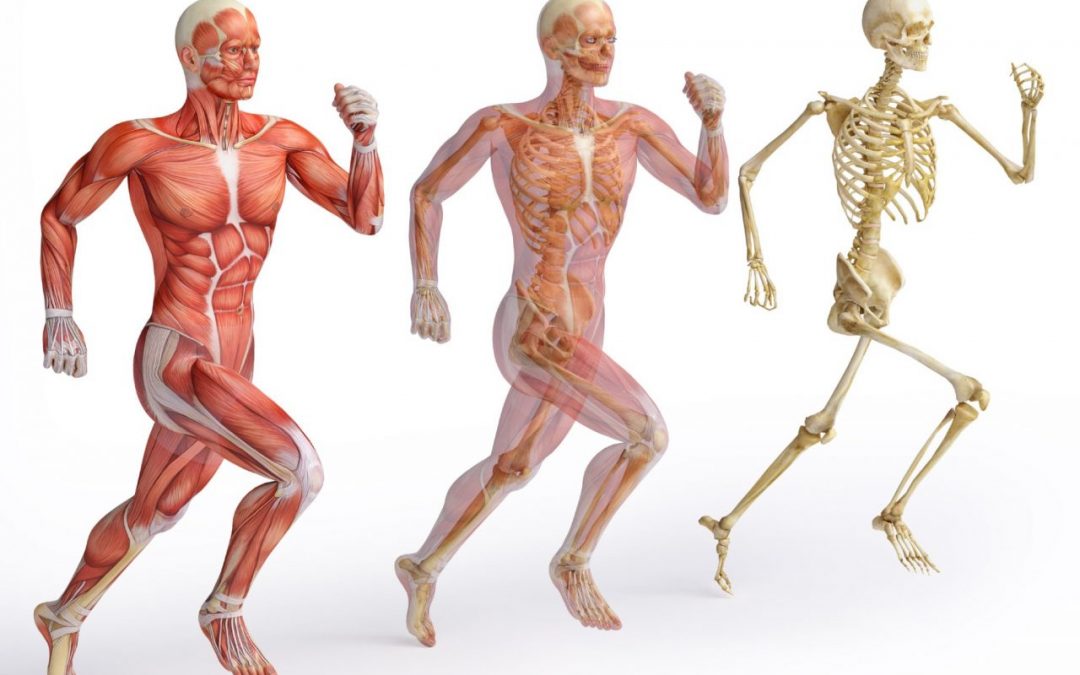Musculoskeletal refers to the muscle and the bones in the body. The musculoskeletal system comprises the skeleton, joints, muscles, tendons, cartilage, sinews, and other tissues that support the tissues and organs in the body. It is the system that attaches the bones to the muscles and plays a part in movement – joints connect bones to allow mobility, the bones are prevented from rubbing against each other by cartilage, and the muscles in the body contract to allow movement of the bone attached to a joint.
The Musculoskeletal Sub-systems
- Skeleton
The skeleton is made up of bones that provide shape for the body. It does not just provide shape. It provides support for the body and protection for the internal organs such as the skull that serves as protection for the brain. The bones also store minerals for the body.
- Muscle
Muscles are attached to the bones and skin in the body. Muscles contract as we move and so very essential for mobility. Its major function is to allow movement of the body. Muscles also have other functions. They help to manage blood sugar, support joints, control body fat, build stamina, and many more.
- Tendons
Tendons are connective tissues. They are found at the end of each muscle and connect muscles to the bones in the body.
- Joints
A joint is a point where two bones meet. There are different types of joints in the body. Most joints are movable but not all joints are movable.
- Ligaments
Ligaments are strong elastic tissues that surround the joint. They help to prevent tearing of the joints and to keep them stable.
Musculoskeletal Disorders
Musculoskeletal disorders are injuries or pain that affect the musculoskeletal system. All the components of musculoskeletal systems in the body are interrelated. Musculoskeletal pain affects all the components of the musculoskeletal system. This pain can occur in any part of the body.
Musculoskeletal disorders are more prevalent among older people. Still, younger people are also affected. Younger people are affected majorly during their income-earning years. Poor sitting posture at work is one of the major causes of lower back pain. Studies show that the number of people with low back pain will increase rapidly in the coming years.
The pain can either be acute or chronic. There are different types of musculoskeletal pain. The type of pain depends on which component of the musculoskeletal component is directly affected. Bone pain is usually more intense and penetrating than pain in the other musculoskeletal components.
Musculoskeletal disorders are generally categorized by the intensity of the pain, the component the pain affects, and the level of restriction the pain causes on your movement. Another classification is the duration of the pain. Some are transitory while others are lifelong conditions.
Broad Classification of Musculoskeletal Disorders
- Primary muscle diseases
Primary muscle diseases are serious and critical muscle diseases. Primary muscle diseases affect the muscle directly. That is, the disease starts from the affected muscle. They can be caused by different things depending on what part of the body the affected muscle is. Primary muscle disease is treated by treating the affected muscle. As with the causes, the mode of treatment will depend on the affected muscle. Primary muscle diseases include but are not limited to cardiomyopathy, inflammatory myopathies, among others.
Let’s take cardiomyopathy as a case study. Cardiomyopathy is a disease of the heart muscle. It is a progressive disease that makes the heart abnormally large and stiff, making it hard for it to perform its main function – to pump blood. Cardiomyopathy can eventually lead to heart failure. Cardiomyopathy can be caused by diabetes or other metabolic disorders, obesity, alcoholism to mention a few. Cardiomyopathy is usually treated with surgery.
- Secondary muscle diseases
Secondary muscle diseases are muscle diseases that are not as critical as primary muscle diseases. Secondary muscle diseases are usually a result of other critical health conditions or infectious diseases. Secondary muscle diseases are treated by treating the underlying condition that caused the muscle disease and then treating the affected muscle.
Causes of Musculoskeletal Disorder
There are different causes of musculoskeletal pain are varied. We are constantly using our bodies and this causes wear and tear. This wear and tear affect the musculoskeletal system. Other causes are trauma, accidents, repetitive movements, prolonged immobilization, and poor posture.
Work environment and posture are also the major causes of musculoskeletal disorders. The persistent nature of bad work posture causes pain back pain and other musculoskeletal pains.
Symptoms of Musculoskeletal Disorders
Symptoms of musculoskeletal pain vary from person to person. The symptoms also depend on the type of musculoskeletal disease that an individual has. However, there some common symptoms of it. They include pain, fatigue, spasms, twitching, dizziness, high fever, problems with swallowing, numbness, double vision, imbalance, and many more.
Musculoskeletal disorders can lead to health and mental decline in an individual. if you experience any symptoms, it is best to contact your doctor to help diagnose and determine the cause.
How to Prevent Musculoskeletal Pain
You can prevent musculoskeletal diseases to avoid all the medical expenses that come with it. Tips to help you include:
- Keeping a healthy diet
- Exercising regularly
- Using adjustable beds
- Develop and maintain good posture both for sitting and for general movements.
- Proper stretching
- Use comfortable furniture and tools.
- Employers should organize seminars and workshops to enlighten employees about proper work postures. They should also get work furniture that will help employees maintain proper postures.
How to Treat Musculoskeletal Pain
There are different ways to treat musculoskeletal pain. One popular method is physical therapy. Physical therapy helps to improve mobility in the body and improve balance. It is a very effective way to treat musculoskeletal pain.
Medications are also used to treat musculoskeletal pain. Certain musculoskeletal disorders like Fibromyalgia are treated with medications. Medications increase the body’s serotonin and norepinephrine levels. Other forms of treatments are anti-inflammatory medications, exercise. Acupuncture, chiropractic care, therapeutic massage to mention a few.

